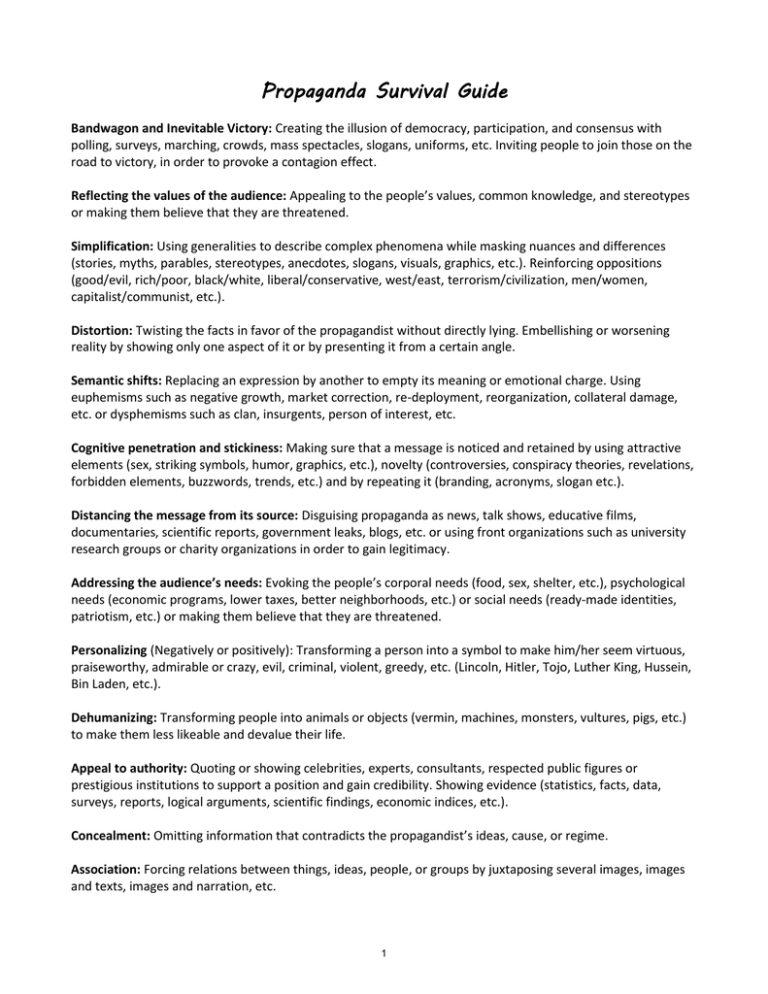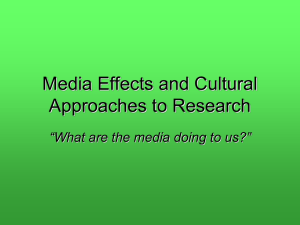Propaganda Survival Guide
advertisement

Propaganda Survival Guide Bandwagon and Inevitable Victory: Creating the illusion of democracy, participation, and consensus with polling, surveys, marching, crowds, mass spectacles, slogans, uniforms, etc. Inviting people to join those on the road to victory, in order to provoke a contagion effect. Reflecting the values of the audience: Appealing to the people’s values, common knowledge, and stereotypes or making them believe that they are threatened. Simplification: Using generalities to describe complex phenomena while masking nuances and differences (stories, myths, parables, stereotypes, anecdotes, slogans, visuals, graphics, etc.). Reinforcing oppositions (good/evil, rich/poor, black/white, liberal/conservative, west/east, terrorism/civilization, men/women, capitalist/communist, etc.). Distortion: Twisting the facts in favor of the propagandist without directly lying. Embellishing or worsening reality by showing only one aspect of it or by presenting it from a certain angle. Semantic shifts: Replacing an expression by another to empty its meaning or emotional charge. Using euphemisms such as negative growth, market correction, re-deployment, reorganization, collateral damage, etc. or dysphemisms such as clan, insurgents, person of interest, etc. Cognitive penetration and stickiness: Making sure that a message is noticed and retained by using attractive elements (sex, striking symbols, humor, graphics, etc.), novelty (controversies, conspiracy theories, revelations, forbidden elements, buzzwords, trends, etc.) and by repeating it (branding, acronyms, slogan etc.). Distancing the message from its source: Disguising propaganda as news, talk shows, educative films, documentaries, scientific reports, government leaks, blogs, etc. or using front organizations such as university research groups or charity organizations in order to gain legitimacy. Addressing the audience’s needs: Evoking the people’s corporal needs (food, sex, shelter, etc.), psychological needs (economic programs, lower taxes, better neighborhoods, etc.) or social needs (ready-made identities, patriotism, etc.) or making them believe that they are threatened. Personalizing (Negatively or positively): Transforming a person into a symbol to make him/her seem virtuous, praiseworthy, admirable or crazy, evil, criminal, violent, greedy, etc. (Lincoln, Hitler, Tojo, Luther King, Hussein, Bin Laden, etc.). Dehumanizing: Transforming people into animals or objects (vermin, machines, monsters, vultures, pigs, etc.) to make them less likeable and devalue their life. Appeal to authority: Quoting or showing celebrities, experts, consultants, respected public figures or prestigious institutions to support a position and gain credibility. Showing evidence (statistics, facts, data, surveys, reports, logical arguments, scientific findings, economic indices, etc.). Concealment: Omitting information that contradicts the propagandist’s ideas, cause, or regime. Association: Forcing relations between things, ideas, people, or groups by juxtaposing several images, images and texts, images and narration, etc. 1 Disinformation: Introducing false information, rumors and lies. Recuperation: Appropriating myths, cultural referents, collective fears, hopes or resentment, in order to serve the propagandist cause. Appeal to the heartstrings: Creating emotions and touching people’s hearts instead of stimulating reasoning and critical thinking. References Domenach, Jean-Marie. 1992. La propagande politique. Paris: PUF. Herman, Edward S. and Noam Chomsky. 2002. Manufacturing Consent. New York: Pantheon Books. Patrick, Brian Anse. 2013. The Ten Commandments of Propaganda. London: Arktos. Roland, Jon. 1998. “Propaganda Technique”. Constitution Society. Website: http://www.constitution.org/col/propaganda_army.htm Tchakhotine, Serge. 1992. Le viol des foules par la propagande politique. Paris: Gallimard. 2 MIT OpenCourseWare http://ocw.mit.edu CMS.701 / CMS.901 Current Debates in Media Spring 2015 For information about citing these materials or our Terms of Use, visit: http://ocw.mit.edu/terms.



